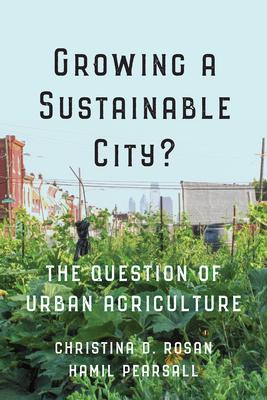Urban agriculture offers promising solutions to many different urban problems, such as blighted vacant lots, food insecurity, storm water runoff, and unemployment. These objectives connect to many cities' broader goal of "sustainability," but tensions among stakeholders have started to emerge in cities as urban agriculture is incorporated into the policymaking framework.
Growing a Sustainable City? offers a critical analysis of the development of urban agriculture policies and their role in making post-industrial cities more sustainable. Christina Rosan and Hamil Pearsall's intriguing and illuminating case study of Philadelphia reveals how growing in the city has become a symbol of urban economic revitalization, sustainability, and - increasingly - gentrification. Their comprehensive research includes interviews with urban farmers, gardeners, and city officials, and reveals that the transition to "sustainability" is marked by a series of tensions along race, class, and generational lines. The book evaluates the role of urban agriculture in sustainability planning and policy by placing it within the context of a large city struggling to manage competing sustainability objectives. They highlight the challenges and opportunities of institutionalizing urban agriculture into formal city policy. Rosan and Pearsall tell the story of change and growing pains as a city attempts to reinvent itself as sustainable, livable, and economically competitive.
Book
Growing a Sustainable City?: The Question of Urban Agriculture
(Write a Review)
Paperback
$34.95
Urban agriculture offers promising solutions to many different urban problems, such as blighted vacant lots, food insecurity, storm water runoff, and unemployment. These objectives connect to many cities' broader goal of "sustainability," but tensions among stakeholders have started to emerge in cities as urban agriculture is incorporated into the policymaking framework.
Growing a Sustainable City? offers a critical analysis of the development of urban agriculture policies and their role in making post-industrial cities more sustainable. Christina Rosan and Hamil Pearsall's intriguing and illuminating case study of Philadelphia reveals how growing in the city has become a symbol of urban economic revitalization, sustainability, and - increasingly - gentrification. Their comprehensive research includes interviews with urban farmers, gardeners, and city officials, and reveals that the transition to "sustainability" is marked by a series of tensions along race, class, and generational lines. The book evaluates the role of urban agriculture in sustainability planning and policy by placing it within the context of a large city struggling to manage competing sustainability objectives. They highlight the challenges and opportunities of institutionalizing urban agriculture into formal city policy. Rosan and Pearsall tell the story of change and growing pains as a city attempts to reinvent itself as sustainable, livable, and economically competitive.Paperback
$34.95